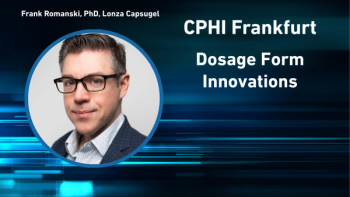
Pharmaceutical Technology Europe
- Pharmaceutical Technology Europe-03-01-2012
- Volume 24
- Issue 3
News: Market Boom for Generics
The pharma industry has reached the long-dreaded patent cliff, but for copycat products, business is booming.
The pharma industry has reached the longdreaded patent cliff and profits for branded medicines are plummeting because of generic erosion. For copycat products, on the other hand, business is booming. Analyst firm Frost & Sullivan has recently released two reports examining the markets for generic drugs and biosimilars respectively, and has predicted huge growth for both in the lead up to 2017.
Generic drugs
According to Frost & Sullivan's report, Generic Pharmaceuticals Market — A Global Analysis, pharmaceutical products worth $150 billion will go off patent between 2010 and 2017, which will propel the generic-drugs market from revenues of $123.85 billion in 2010 to an estimated $231 billion by 2017.
However, as competition intensifies, genericdrug manufacturers will need to carefully consider their product segments and the appropriate time for market launch. Companies will also have to deal with increasingly harsher costcutting measures from governments and healthcare service providers. Although generic products are often favoured over branded medicines because of their lower cost, the profit margins of generic manufacturers are still likely to be squeezed. According to the report, many generic manufacturers, including Teva, Sandoz and Mylan, are opting to produce higher value products, such as difficult to produce generics, specialty products and biosimilars.
In a press statement, Aiswariya Chidambaram, a research analyst at Frost & Sullivan, advised, "Large multinational generic firms need to adopt a differentiated approach by opting for products with technologically challenging formulations, products which require significant regulatory support and products with limited availability of active pharmaceutical ingredients."
Another strategy being adopted by genericdrug companies is to forge alliances with branded pharma for marketing and exclusivity rights to certain generic blockbusters, such as Lipitor and Crestor, among others.
Biosimilars
The global biosimilars market earned revenues of around $172 million in 2010, but this is estimated to jump to $3987 million in 2017, with the industry growing at a compound annual growth rate of approximately 56.7%. According to Frost & Sullivan's Analysis of European Biosimilars Market report, impending patent expiries are expected to provide impetus to the market development of several new biosimilars.
But strong growth doesn't necessarily mean that there will be a sudden boom of new developers seeking to enter the market. Although biosimilars offer "lucrative growth prospects," high investment is also required because of the complex production processes, expensive biological and chemical materials, rigorous clinical trials and stringent quality and safety tests, which are all needed for development. High manufacturing costs can also act as a barrier to market entry, but this can be overcome by using license agreements between companies.
"The need for considerable financial outlays will hinder the entry of small biotech firms in particular," Frost & Sullivan analyst Srinivas Sashidhar said in a press statement."On the other hand, specialty pharmaceutical companies with biotech expertise and financial capabilities are well positioned to venture into the biosimilars market."
As with generic smallmolecule drugs, biosimilars are likely to be used in healthcare programmes in place of branded biopharmaceutical products for cost reasons. However, developing a biosimilar is much riskier than a traditional pharmaceutical. Biosimilars are highly complex and there is no guarantee that regulators will accept the product's similarity to its biological counterpart. In the US, in particular, the regulatory pathway for biosimilars is still very new. Uncertainty also remains about how successful a biosimilar will be in the market. According to Frost & Sullivan, one important factor to help achieve success will be effective communication with the scientific community, including close interaction with doctors and pharmacists to promote the benefits of biosimilars and increase uptake.
News bites
Pharmacovigilance update
The EMA has published an implementation plan for Europe's new pharmacovigilance legislation, which comes into force in July. The legislation will improve the safety and risk–benefit monitoring of drugs and represents the biggest change in the EMA's legal framework.
Fighting tropical diseases
Pfizer, Sanofi, GlaxoSmithKline and other major companies and global healthcare organisations have joined forces and pledged to defeat 10 neglected tropical diseases by 2020. The companies will donate an average of 1.4 billion treatments each year, while new collaborative R&D is expected to lead to new treatment options.
Jobs axed at AstraZeneca
AstraZeneca has announced restructuring initiatives that could lead to 7300 job losses. Positions affected include those in selling, general and administrative areas, as well as operations and neuroscience R&D. The restructuring is expected to deliver around $1.6 billion in annual benefits by the end of 2014.
FDA's Heparin guidance
The FDA has released a draft guidance for API manufacturers that provides recommendations for procedures to ensure that crude heparin does not contain oversulfated chondroitin sulphates or nonporcine origin material. The guidance is titled Heparin for Drug and Medical Device Use: Monitoring Crude Heparin for Quality.
Articles in this issue
almost 14 years ago
Stepping Up the Fight Against Counterfeitsalmost 14 years ago
Parametric Release and Real-Time Release Testingalmost 14 years ago
Evaluating Impurities in Drugs (Part II of III)almost 14 years ago
Securing the Pharma Supply Chainalmost 14 years ago
CMOs Face a Kodak Momentalmost 14 years ago
Single-Use Redundant FiltrationNewsletter
Get the essential updates shaping the future of pharma manufacturing and compliance—subscribe today to Pharmaceutical Technology and never miss a breakthrough.




